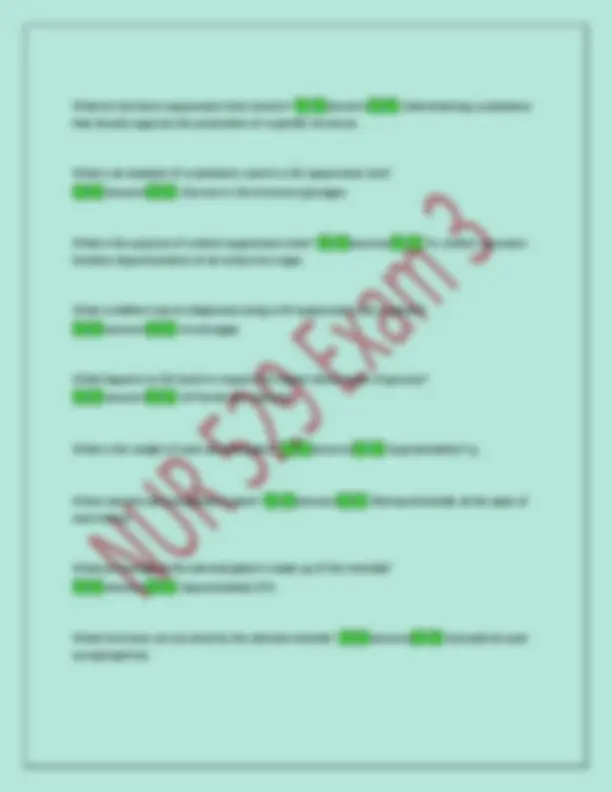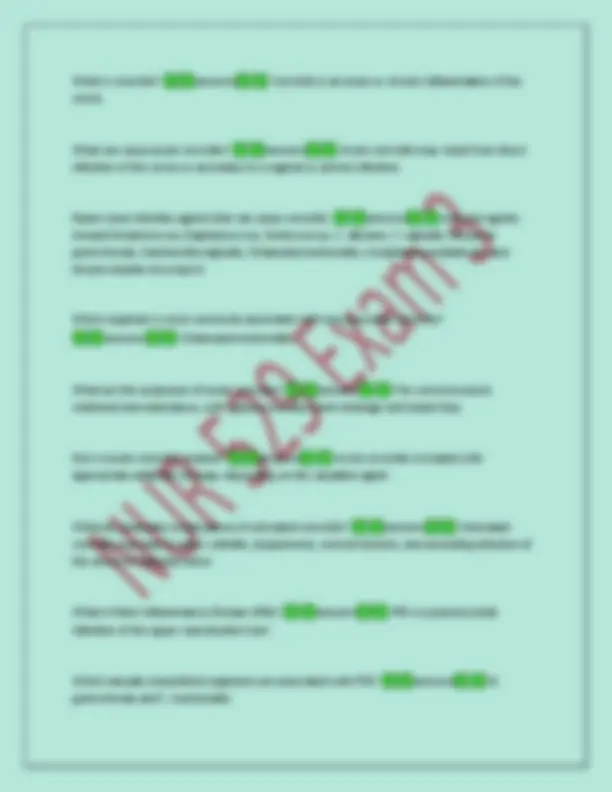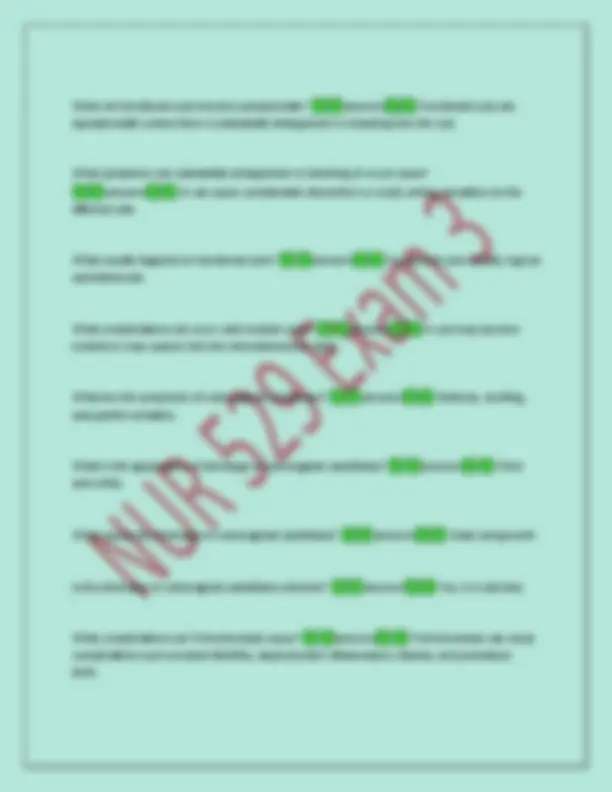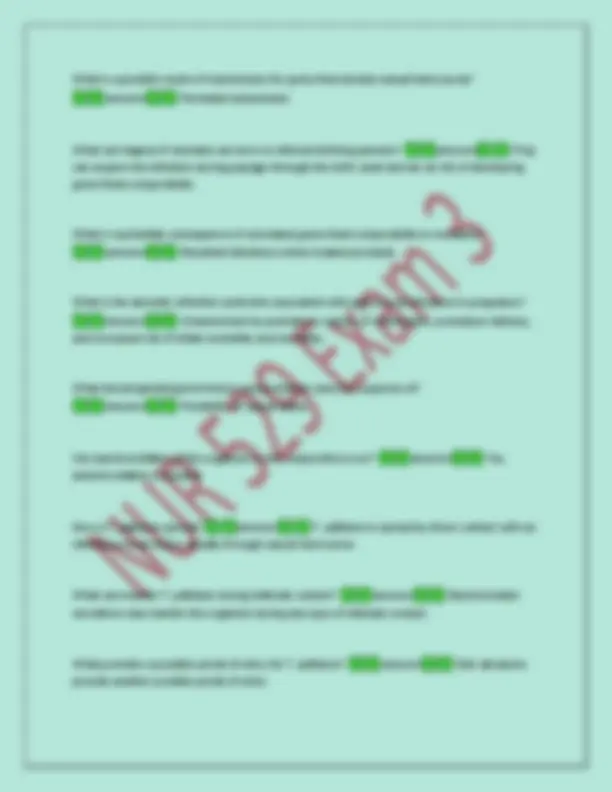








































Study with the several resources on Docsity

Earn points by helping other students or get them with a premium plan


Prepare for your exams
Study with the several resources on Docsity

Earn points to download
Earn points by helping other students or get them with a premium plan
Community
Ask the community for help and clear up your study doubts
Discover the best universities in your country according to Docsity users
Free resources
Download our free guides on studying techniques, anxiety management strategies, and thesis advice from Docsity tutors
University of Alabama NUR 529 Exam 3 QUESTIONS AND CORRECT ANSWERS| ACCURATE REAL EXAM WITH FREQUENTLY TESTED QUESTIONS|ALREADY A GRADED|GUARANTEED PASS|LATEST UPDATE 2025
Typology: Exams
1 / 46

This page cannot be seen from the preview
Don't miss anything!







































What percentage of erythropoietin is produced by the kidney? answers :Approximately 90% What are common causes of primary gout? answers :Enzyme defects that result in overproduction of uric acid or inadequate elimination of uric acid by the kidney. Is the reason for most cases of gout known? answers :No, in most cases, the reason is unknown. What are fungi? answers :Fungi are free-living, saprophytic plantlike organisms.
What is included in the normal skin flora? answers :Certain strains of fungi. What are the two types of fungi? answers :Yeasts and molds. How do yeasts, such as Candida albicans, reproduce? answers :Yeasts reproduce asexually. What is the structure of molds? answers :Molds grow in long filaments called hyphae. How many species of yeasts and molds are known to cause disease in humans and animals? answers :About 100 species. What are fungal infections of the skin classified as? answers :Superficial or deep. What are superficial mycoses more commonly known as? answers :Tinea or ringworm. What do superficial mycoses invade? answers :Only the superficial keratinized tissue (skin, hair, and nails). What do deep fungal infections involve? answers :The epidermis, dermis, and subcutaneous tissue. How can infections that are typically superficial behave in immunosuppressed individuals? answers :They may exhibit deep involvement.
What are satellite lesions in candidal infections? answers :Satellite lesions are maculopapular and are found outside the clearly demarcated borders of the candidal infection. How can candidal infections be differentiated from tinea infections? answers :Candidal infections can often be differentiated by the presence of satellite lesions. What is a common diagnostic method for candidal infections? answers :Diagnosis usually is based on microscopic examination of skin or mucous membrane scrapings placed in a KOH solution. What preventive measures are recommended for hand infections? answers :Wearing rubber gloves is encouraged for people with infections of the hands. How can intertriginous areas be managed to prevent candidal infections? answers :Intertriginous areas can be separated with clean cotton cloth and allowed to air dry. What types of antifungal agents are used in the treatment of candidiasis? answers :Topical and oral antifungal agents such as clotrimazole, econazole, and miconazole are used depending on the site and extent of involvement. What is impetigo? answers :Impetigo is a common, superficial bacterial infection. What bacteria commonly cause impetigo? answers :Impetigo is caused by staphylococci or group A beta-hemolytic streptococci.
Who is most commonly affected by impetigo? answers :Impetigo is common among infants and young children. When does impetigo most commonly occur? answers :Its occurrence is highest during warm summer months or in warm, moist climates. What are the initial symptoms of impetigo? answers :Impetigo initially appears as a small vesicle, pustule, or large bulla. What happens when the primary lesion of impetigo ruptures? answers :It leaves a denuded area that discharges a honey-colored serous liquid that hardens and dries as a honey- colored crust. What symptom often accompanies impetigo lesions? answers :Pruritus often accompanies the lesions. What is a possible complication of untreated streptococcal impetigo? answers :A possible complication is poststreptococcal glomerulonephritis. What is the first choice treatment for impetigo? answers :Topical mupirocin (Bactroban) is effective in treating impetigo. What should be used if a larger area is involved in impetigo? answers :A systemic antibiotic may be necessary. What is herpes zoster commonly known as? answers :Shingles
How long may prodromal symptoms be present before the appearance of the rash in herpes zoster? answers :1 to 3 days or longer. What do the lesions of herpes zoster look like? answers :An eruption of vesicles with erythematous bases restricted to skin areas supplied by sensory neurons of a single or associated group of dorsal root ganglia. In immunosuppressed individuals, how do herpes zoster lesions differ? answers :The lesions may extend beyond the dermatome. Where do herpes zoster eruptions usually occur? answers :Unilateral in the thoracic region, trunk, or face. How long do new groups of vesicles erupt along the nerve pathway in herpes zoster? answers :For 3 to 5 days. What happens to the vesicles in herpes zoster over time? answers :They dry, form crusts, and eventually fall off. How long does it typically take for herpes zoster lesions to clear? answers :Usually in 2 to 3 weeks, although they can persist up to 6 weeks in some older adults. What serious complication can occur with herpes zoster involving the ophthalmic division of the trigeminal nerve? answers :Eye involvement can result in permanent blindness. What is postherpetic neuralgia? answers :Pain that persists longer than 1 to 3 months after the resolution of the rash.
Who is most often affected by postherpetic neuralgia? answers :Those older than 60 years of age. What is the aim in the treatment for both types of contact dermatitis? answers :Removing the source of the irritant or allergen. What is involved in the treatment of minor cases of contact dermatitis? answers :Washing the affected areas, applying antipruritic creams or lotions, and bandaging the exposed areas. What type of medication may be helpful in treating minor cases of contact dermatitis? answers :Topical corticosteroids. How do systemic treatment regimens differ in contact dermatitis? answers :They differ according to the type of irritant or allergen and the severity of the reaction. What does the treatment of moderate to extreme cases of contact dermatitis consist of? answers :Wet dressings, oral antihistamines, and systemic corticosteroids. How are burns classified? answers :Burns are classified according to the depth of involvement as first-degree, second-degree, and third-degree burns. What factors influence the depth of a burn? answers :The depth of a burn is largely influenced by the duration of exposure to the heat source and the temperature of the heating agent. What characterizes first-degree burns? answers :First-degree burns involve only the outer layers of the epidermis, are red or pink, dry, painful, and usually do not form blisters.
What are methods for preventing pressure injuries? answers :Frequent position change, meticulous skin care, and careful observation to detect early signs of skin breakdown. What effect does moisture have on the skin? answers :Moisture macerates and injures skin. What are sources of moisture that can affect skin integrity? answers :Sweat, wound drainage, urine, and feces. How do urinary and fecal incontinence affect the risk of pressure injuries? answers :They increase the risk of pressure injuries. What can increase local skin pressure points in a bed? answers :Food crumbs, intravenous tubing, and other debris. How does the prevention of dehydration benefit skin health? answers :It improves circulation and decreases urine concentration, minimizing skin irritation. Why is maintenance of adequate nutrition important? answers :Anemia and malnutrition contribute to tissue breakdown and delay healing after tissue injury. Why is early detection important for malignant melanoma? answers :Early detection is critical for timely treatment of malignant melanoma. What method can be used for early detection of malignant melanoma? answers :Regular self-examination of the total skin surface in front of a well-lighted mirror.
What tools are recommended for a thorough skin examination? answers :A full mirror, handheld mirror, and handheld hair dryer. What does the ABCD rule stand for in melanoma detection? answers :Asymmetry, Border irregularity, Color variegation, Diameter greater than 6 mm. What size is considered significant for the diameter in the ABCD rule? answers :Greater than 6 mm, which is about the size of a pencil eraser. What changes should people watch for in existing nevi? answers :Changes such as bleeding, itching, or the development of new nevi. What is one factor that contributes to skin aging? answers :Cumulative actinic or environmental damage. What does aged skin often look like? answers :Wrinkled and leathery. What are odd scars and ecchymotic spots associated with? answers :Solar elastotic degenerative changes. What percentage of erythropoietin is produced by the liver and other organs? answers :Approximately 10% How does kidney dysfunction affect red blood cell development? answers :It impacts RBC development and availability. What deficiencies may contribute to anemia in chronic kidney disease (CKD)? answers :Vitamin B12, iron, and folate deficiencies.
What is the major metabolic function of colonic microorganisms? answers :The fermentation of undigestible dietary residue and endogenous mucus. What is a major source of energy in the colon? answers :Fermentation of nondigestible carbohydrates, including resistant starches, cellulose, pectins, and unabsorbed sugars. What role do colonic microorganisms play in vitamin synthesis? answers :They synthesize vitamin K. Why do newborn infants not synthesize adequate amounts of vitamin K initially? answers :Because the normal colonic bacterial flora has not yet become established. What protective role does the resident gut flora provide? answers :It provides a crucial line of resistance to colonization by exogenous microbes. What can disrupt the microbial balance in the gut? answers :The administration of broad-spectrum antibiotics. What is the role of probiotics? answers :They are live microorganisms that can modify the composition of enteric flora when ingested. What are some commonly used probiotics? answers :Lactobacilli, bifidobacteria, and nonpathogenic Escherichia coli. In which disease have probiotics shown value in maintaining remission? answers :Ulcerative colitis.
What can people with aspirin-related gastritis be unaware of? answers :They can be totally unaware of the condition or may complain only of heartburn or sour stomach. What symptoms are associated with gastritis from excessive alcohol consumption? answers :It often causes transient gastric distress, which may lead to vomiting and, in more severe situations, to bleeding and hematemesis. What is the onset time for gastritis caused by staphylococcal enterotoxins? answers :It usually has an abrupt and violent onset, with gastric distress and vomiting occurring approximately 5 hours after ingestion of contaminated food. Is acute gastritis a self-limiting disorder? answers :Yes, acute gastritis is usually a self-limiting disorder, with complete regeneration and healing occurring within several days of removal of the inciting agent. What is the primary treatment for celiac disease? answers :Removal of gluten and related proteins from the diet. What grains contain gluten? answers :Wheat, barley, and rye. Can oat products be safe for people with celiac disease? answers :Oat products are nontoxic but may be contaminated with wheat during processing. What types of products are available for those on a gluten-free diet? answers :Many gluten-free types of bread, cereals, cookies, and other products. Which food groups are generally free of gluten? answers :Meats, vegetables, fruits, and dairy products.
Why are premature infants at particular risk for hyperbilirubinemia? answers :Their red cells have a shorter lifespan and higher turnover rate. What are the characteristics of prehepatic jaundice? answers :Mild jaundice, elevated unconjugated bilirubin, normal colored stools, and no bilirubin in the urine. What are the known hepatotropic viruses? answers :Hepatitis A virus (HAV), hepatitis B virus (HBV), hepatitis B-associated delta virus (HDV), hepatitis C virus (HCV), and hepatitis E virus (HEV). What do all hepatotropic viruses cause? answers :Acute hepatitis. What factors do hepatotropic viruses differ in? answers :Mode of transmission, incubation period, mechanism, degree and chronicity of liver damage, and ability to evolve to a carrier state. How can the presence of viral antigens and their antibodies be determined? answers :Through laboratory tests. What other viruses have been shown to be hepatotropic? answers :Human pegivirus (HGV), TT virus (TTV), Sanban virus, Yonban virus, SEN virus, and TTV-like minivirus. What is known about the causality of other hepatotropic viruses with liver disease? answers :Causality with significant acute or chronic liver disease has been difficult to establish. What is the NV-F viruslike agent associated with? answers :It may exacerbate the severity of chronic hepatitis C.
What percentage of blood donors in the United States have evidence of HGV? answers :1.7%. Is HGV linked to liver disease? answers :No, HGV is not linked to liver disease or exacerbations of liver disease. What controls hunger and satiety? answers :A complex group of neurohormones. Where are many neurohormones that control hunger produced? answers :In the gastrointestinal tract. What is the function of neurohormones related to hunger? answers :To stimulate hunger or signal satiety. What effects do neurohormones control regarding hunger and satiety? answers :Both short- and long-term effects. Is there still much to learn about the management of hunger and satiety? answers :Yes, there is still much to be learned. What are the two types of central obesity differentiated by imaging scans? answers :Intra-abdominal adipose tissue (visceral fat) and subcutaneous abdominal adipose tissue. What imaging techniques are used to differentiate types of central obesity? answers :Computed tomography and magnetic resonance imaging scans.
What are the techniques of nutritional assessment? answers :Techniques of nutritional assessment include evaluation of dietary intake, anthropometric measurements, nutrition-focused physical examination, and laboratory tests. What can be evaluated in body composition assessment? answers :Body composition can be assessed with weight, edema, muscle wasting, and subcutaneous fat loss. What is prealbumin used for? answers :Prealbumin is used in the diagnosis of protein-calorie malnutrition. Why is albumin less sensitive to changes in nutrition than prealbumin? answers :Albumin has a relatively large body pool and a half-life of 20 days, making it less sensitive to changes in nutrition than prealbumin, which has a shorter half-life and a relatively small body pool. What are hormone stimulation tests used for? answers :They are used when decreased functioning of an endocrine organ is suspected. What is administered during hormone stimulation tests? answers :A tropic, or stimulating, hormone. How is the capacity of a target gland to respond measured in hormone stimulation tests? answers :By an increase in the appropriate hormone. What can be evaluated through stimulation testing for GH response? answers :The adequacy of functioning of the hypothalamic-pituitary system for the production of GH. What hormone is assessed in the hypothalamic-pituitary-adrenal system using ACTH stimulation? answers :Cortisol.
What do hormone suppression tests involve? answers :Administering a substance that should suppress the production of a specific hormone. What is an example of a substance used in a GH suppression test? answers :Glucose or the hormone glucagon. What is the purpose of cortisol suppression tests? answers :To confirm excessive function (hyperfunction) of an endocrine organ. What condition may be diagnosed using a GH suppression test in adults? answers :Acromegaly. What happens to GH levels in response to higher blood levels of glucose? answers :GH levels are reduced. What is the weight of each adrenal gland? answers :Approximately 5 g Where are the adrenal glands located? answers :Retroperitoneally at the apex of each kidney What percentage of the adrenal gland is made up of the medulla? answers :Approximately 20% What hormones are secreted by the adrenal medulla? answers :Epinephrine and norepinephrine